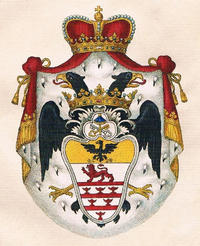Odescalchi
The Odescalchi are a family of Italian nobility who grew up in the 16th and 17th centuries to considerable wealth and through Pope Pope Innocent XI. came to political importance. To this day she is one of the papal nobility as well as the European nobility .
history
The family can be traced back to Como in the middle of the 14th century . As a family belonging to the upper middle class of her time, she was involved in trade, especially in the textile sector since the 15th century. In the 16th century, the establishment of a branch of the family falls in Rome , also in this period, the Odelscalchi dive into Milanese on court offices, for which a needle check was necessary. The widely ramified family clan later increasingly secured its economic base through banking and land ownership, which made it one of the richest families in Italy at the beginning of the 17th century.
To maintain wealth (or to keep it together), more and more male family members had to pursue a career as a cleric . Benedetto Odescalchi (1611–1689) came from a rather less well-heeled side line, who from 1676 as Pope Innocent XI. Bishop of Rome and his pontificate is characterized by a rigorous austerity policy and the containment of the escalating nepotism of his time . Innocent XI. is now considered the most important Pope of the 17th century.
Benedetto's nephew Livio Odescalchi (~ 1652–1713), to whom his uncle refused the cardinal's hat, but elevated him to Duke of Ceri (south of Bracciano), amassed an immense fortune, made a name for himself as a collector of antiquities and secured the family a place in the Roman nobility. In 1697 he was brought into play as one of eight candidates for the Polish throne, which August the Strong eventually won. After Livio took part in the defense against the Second Turkish Siege of Vienna , Emperor Leopold I made him Prince of the Empire and Duke of Syrmia and Sava. In these areas, which at that time belonged to the Kingdom of Hungary , he was enfeoffed with goods.
Livio Odescalchi was, however, the last of the older line from which the Pope came (a younger one in Como did not go out until 1852). The Erba-Odescalchi family emerged from the connection between Livio's sister Lucrezia and Alessandro Erba . To continue his line, the Pope adopted Lucrezia's son Antonio Maria Erba (1624-1694) and raised him in 1684 to Marchese di Mondonico . Antonios Maria's older son Alessandro Erba-Odescalchi (1677–1757) continued the line of the Marchesi di Mondonico, which went out in 1919, while the younger, Baldassarre (1683–1746) was elevated to Principe Odescalchi in 1714 and the princely one that still flourishes today Line justified. It still owns the Palazzo Odescalchi in Rome, the Castello Odescalchi in Bracciano (private museum with rich collections), the Castello Odescalchi in Palo near Ladispoli (since 1780) and the Castello di Santa Marinella (since 1887). Today's head of the family is Principe Don Carlo Odescalchi, 11th Principe Odescalchi, 11th Duca di Bracciano, 11th Duca di Sirmio , Principe di Bassano , 10th Imperial Prince, Grandee of Spain (* 1954), residing in Rome and Santa Marinella.
The Orsini-Odescalchi Castle above the town of Bracciano
Santa Marinella Castle
Prince Innocenzo (1778–1833) fled to Hungary during the Napoleonic occupation of Italy. He later told the family property among his sons: while the elder, Prince Livio (1805-1885), the goods in the Papal States inherited, was the younger, Prince August (1808-1848), in Austria-Hungary naturalized and received the local possessions (including Solčany , Skýcov and Palais in Bratislava and Budapest ). The Hungarian branch inherited the Palais Odescalchi in Vienna from Count Pálffy in 1918 , but sold it in 1966. Expropriated in Hungary and Czechoslovakia in 1945, the descendants went to England, the USA and Austria.
Name bearer
- Giorgio Odescalchi (1564–1620), Bishop of Alessandria (1596–1610) and Vigevano (1610–1620), beatified
- Benedetto Odescalchi (1611–1689), Pope Pope Innocent XI since 1676 .
- Giulio Maria Odescalchi (? - 1666), Bishop of Novara since 1656, brother of the future Pope
- Livio Odescalchi (~ 1652–1713), papal nephew and general
- Benedetto Erba Odescalchi (1679–1740), cardinal, great-nephew of Innocent XI, 1712–36 Archbishop of Milan
- Antonio Maria Erba Odescalchi (1712–1762), cardinal
- Carlo Odescalchi (1785–1841), Jesuit, cardinal, a. a. Archbishop of Ferrara (1823–26), then Cardinal to the Curia
- Pietro Odescalchi (1789–1856), President of the Pontifical Academy of Archeology and the Accademia Nazionale dei Lincei
- Baldassare Ladislao Odescalchi (1844–1909), 6th prince, Italian politician and member of parliament, founder of the seaside resort of Ladispoli near Rome
Caterina Odescalchi (1765–1839), Duchess of Bracciano, Sirmio and Ceri, Angelika Kauffmann (1783)
The Odescalchi belong, next to the Borghese and their side line Aldobrandini as well as the families Barberini , Caetani , Chigi , Colonna , Doria Pamphilj , Lante della Rovere, Massimo , Orsini , Pallavicini , Riario Sforza , Ruspoli and Torlonia to the most famous royal houses of the urban Roman high nobility .
literature
- Volker Reinhardt : Odescalchi. In: Volker Reinhardt (ed.): The great families of Italy (= Kröner's pocket edition . Volume 485). Kröner, Stuttgart 1992, ISBN 3-520-48501-X , p. 378 ff.
- Oesterreichische National-Enzyklopädie (N to Sedria.), Volume 4, Vienna 1838, Odescalchi, the sex , pp. 76 to 78 Google Books , Austrian National Library, digitized on March 4, 2016









